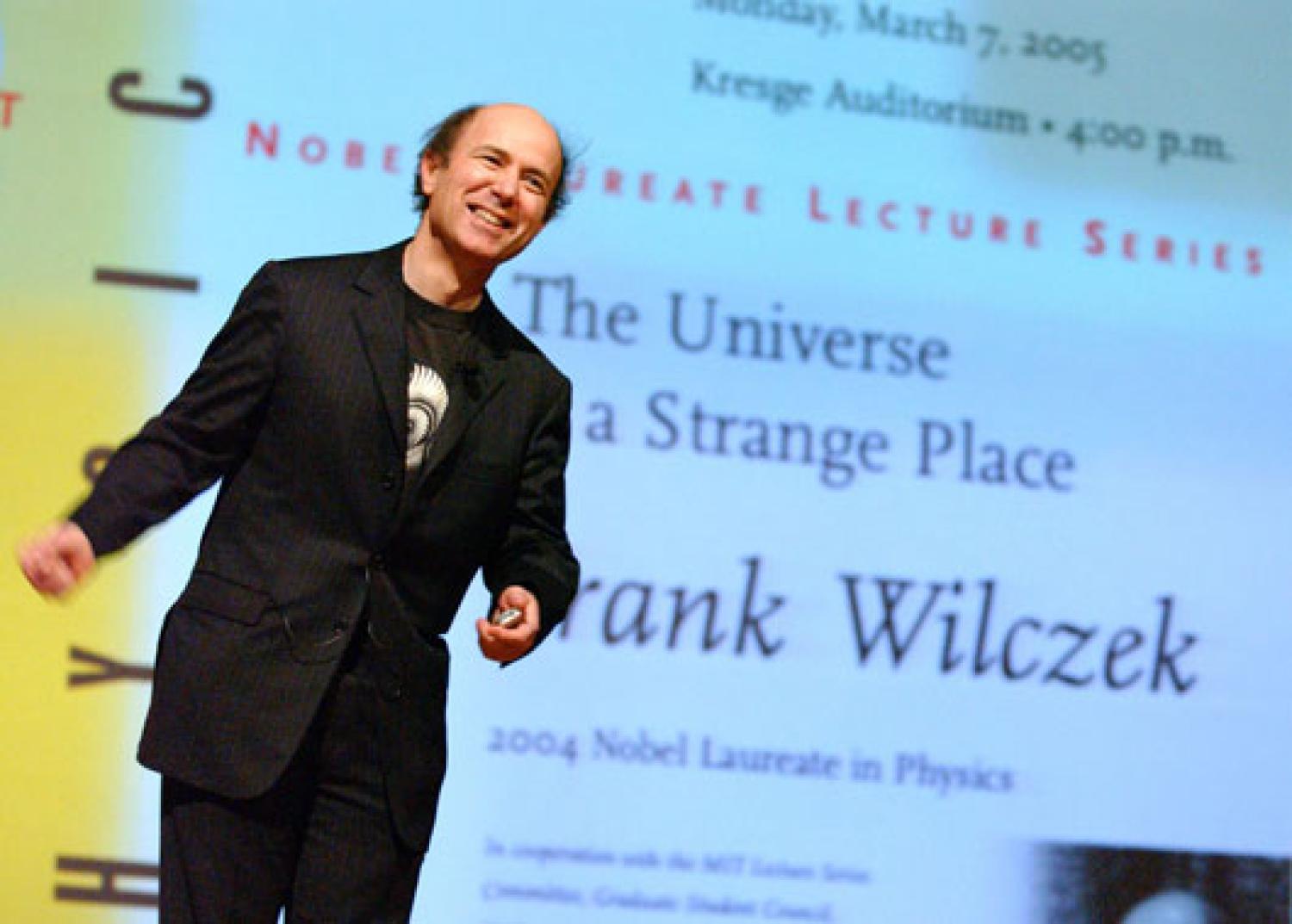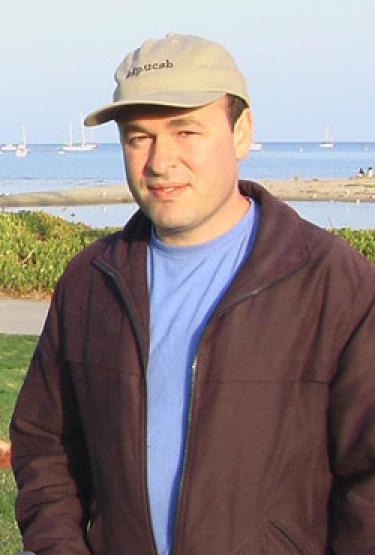
Frank Wilczek likens Large Hadron Collider to Egyptian pyramids and praises “landmark” work of team involving CU physicist
To Frank Wilczek, the Large Hadron Collider may be the defining symbol of modern culture—like the pyramids of ancient Egypt, only better.
He has the credentials to back that bold assertion. Wilczek, Herman Feshbach Professor of Physics at the Massachusetts Institute of Technology, is a 2004 Nobel Laureate in Physics.
The LHC is the world’s largest particle accelerator, which promises to “revolutionize our understanding from the minuscule world deep within atoms to the vastness of the universe.”
Wilczek is scheduled to give the 46th George Gamow Memorial Lecture at the University of Colorado Boulder on April 26. The annual event, which is free and open to the public, will be held at Macky Auditorium at 7:30 p.m.
Wilczek has titled his talk, “Anticipating a New Golden Age: A Vision and Its Fiery Trial at the Large Hadron Collider.” Meanwhile, Wilczek has recently bestowed high praise on a CU physicist and his colleagues for “landmark” work that could help lay the groundwork for ultra-powerful quantum computers.
As Wilczek puts it, the LHC “will enable us to see whether some gorgeous ideas about the ultimate laws of physics describe reality correctly.”
In his talk, Wilczek plans to describe the LHC first as an “awesome physical object and engineering project.” He’ll explain its design and the job it’s meant to do.
Wilczek has a vision for the next level of “unification” in physics, and that vision suggests specific new phenomena that should become visible using the LHC, he says.
He will also emphasize why “this is an especially exciting time to be a physicist.”
The grandson of immigrants from Poland and Italy, Wilczek grew up in the New York City Borough of Queens and went to public schools. He went to the University of Chicago at 15 and wrote his doctoral thesis—for which he later shared the Nobel Prize—at 21.
He and fellow researcher David Gross proposed a theory called quantum chromodynamics, which describes the strong force binding certain particles.
Besides the fact that he is delivering the Gamow Memorial Lecture and that work at the LHC includes about 10 CU researchers, Wilczek has another connection to the university. He recently offered high praise to the work of a team of physicists that includes Victor Gurarie, CU associate professor of physics.
Working with Chetan Nayak of the University of California at Santa Barbara and Parsa Bonderson at UCSB’s Microsoft Station Q, Gurarie proposed a proof that “low-energy excitations of some quantum Hall states are non-Abelian anyons.”
In the Feb. 7 edition of the journal Physics, Wilczek said it was a “landmark proof” and called the team’s work “a tour de force of physical insight and mathematical ingenuity.”
Particles and dimensions

Victor Gurarie, CU associate professor of physics
Physicists discovered in the 1920s that there are two types of elementary particles: fermions and bosons. Fermions are the particles—such as protons, neutrons and electrons—that combine to form atoms, which in turn make up all matter.
Bosons are particles that transmit interactions between the particles of matter. For example, photon, a quantum of light, is a boson.
But in the 1970s, it was observed that if the world were not three-dimensional, but rather two-dimensional, like a flat surface, additional types of particles would have been possible.
These particles were called anyons and non-Abelians (sometimes called “particles with non-Abelian statistics” or non-Abelian particles).
These particles are unusual in that they “remember” how many times they have circled other particles, and whether they circled them in the clockwise or counterclockwise direction.
The notion of circling in a particular direction exists only in two dimensions.
Anyons remember which particles they circled in the past, but not in what order they circled them, while particles with non-Abelian statistics remember even the order in which they circled other particles. Wilczek is usually credited with coining the word “anyon,” Gurarie notes.
Wilczek has maintained interest in both particle physics (being investigated at LHC) and also in some aspects of condensed matter physics. He wrote a groundbreaking paper with Anthony Zee in 1984 in which the concepts behind the non-Abelian statistics were introduced for the first time.
“So he offered praise to our work because he himself is a major contributor to this subject and follows its progress,” Gurarie observes.
Because the world is three-dimensional, one might think that these strange particles should not exist. “Here comes condensed-matter physics,” Gurarie says. Condensed-matter physics studies phases of matter around us. The matter is made up of a huge number of atoms and electrons.
Some phases of matter—such as solids, liquids and gases—are familiar. Some—such as superconductors—are more exotic. A particular exotic matter is formed by electrons in certain semiconductors that are engineered such that electrons can move only along their surface.
Their motion is thus two-dimensional. In the presence of an additional strong magnetic field, the electrons start behaving in an extraordinary, unconventional way. This phase of electrons is called the “Fractional Quantum Hall Effect”—or FQHE.
Daniel Tsui and Horst Störmer, the experimentalists who discovered it in 1982, and Robert Laughlin, the theorist who gave the first explanation to this effect, shared the Nobel Prize for this discovery in 1998.
In FQHE, the electrons appear to break into pieces. “Of course, to the best of our current knowledge, electrons are the indestructible smallest constituents of matter, yet under these conditions they lump together in a certain strange way so that it appears as if only a part of an electron is present in this lump,” Gurarie adds.
Moreover, in the simplest versions of quantum Hall effect, these lumps are neither bosons nor fermions, but rather anyons—the new type of particles that can appear only in a two-dimensional world.
This effect is observed if all the relevant motion occurs on a two-dimensional surface of a semiconductor—thus anyons are permitted. Laughlin showed that these lumps of electrons were anyons.
Soon after, it was pointed out that under even stronger magnetic fields and if very clean semiconductors were employed, it might be possible to create versions of quantum Hall with not only anyons, but also with particles with non-Abelian statistics.
But no one could actually show this by direct calculation. Rather, this claim was based on a conjecture, a guess, which looked reasonable by analogy with the simpler case of anyons but remained unproved. The mathematical method Laughlin employed in his Nobel Prize-winning work was not powerful enough to show the existence of non-Abelians, Gurarie says.
Quantum computers?
Meanwhile, the idea of particles with non-Abelian statistics received a powerful boost in the last decade when it was realized that these particles could be used to build a quantum computer.
Quantum computers are hypothetical computers that manipulate information in its quantum form. As a result, they are predicted to be far more powerful than even the most powerful currently existing computers or the ones built in the foreseeable future.
A substantial effort has been spent to build a working quantum computer, yet all the existing prototypes suffer from the problem that the quantum information, when stored in the motion of atoms or electrons, is very fragile and tends to disappear after a very short time (usually within nanoseconds).
Yet it was pointed out that non-Abelian particles automatically remember which particles they circled in the past and in what order. This memory is part of what these non-Abelian particles do, and it cannot get lost as long as these particles continue to exist. Therefore, one could store the quantum information in the memory of these particles of what they did in the past without fear of its being lost, Gurarie notes.
One can change this information by making these particles circle one another. The idea of a quantum computer based on such particles is called “topological quantum computing.” A division of Microsoft Corporation, called Microsoft Station Q based at the University of California at Santa Barbara, is dedicated to researching ways to create a topological quantum computer.
FQHE remains the most promising experimental setup in which such particles should exist. Other setups based on superconductors or other exotic materials have been proposed, but even if experimentalists ever succeed in building these setups in their labs, the non-Abelian particles that could be created there are of a rather poor variety, not sufficient for arbitrary quantum computation, Gurarie says.
On the contrary, in the Fractional Quantum Hall Effect, it is conjectured that the non-Abelian particles can be arbitrarily complex, sufficient for any quantum computation. A major effort has been underway to detect these particles in FQHE experiments.
So far, no one was able to either prove or disprove their existence based on the observed data.
Yet despite all this activity, the existence of the non-Abelian particles in FQHE remained a conjecture. “I and my collaborators from UCSB and Microsoft Station Q … decided that it was no longer possible to continue working in this field without really verifying that non-Abelian particles existed in this setup,” Gurarie notes.
“In the last year, we set up a new method of calculation, which had its roots in the original method Laughlin used to prove the existence of anyons, but represented a major development of this method in a new direction.”
The method itself was borrowed from a completely different subfield of physics, the physics of plasmas as well as the physics of superfluidity, representing a well-documented trend in theoretical physics where methods developed for one purpose turned out to be useful for something totally different.
“With this method, we proved the existence of anyons in FQHE, at least under one particular value of the magnetic field.”
This does not yet mean that this problem is completely solved, Gurarie says.
“It turns out that under the condition where our proof works, the anyons are precisely of that ‘poor’ variety mentioned earlier.” To solve the problem of any kind of anyons in FQHE, including the “complex” ones important for quantum computing, the method needs to be developed even further.
“We made partial progress in this direction, yet encountered roadblocks which we have not yet overcome. We believe that with some additional work, this will probably be accomplished in the not-so-distant future.”
For more information on the Gamow Memorial Lecture, see http://phys.colorado.edu/public-outreach/george-gamow-memorial-lecture-series or call 303-579-7468.



